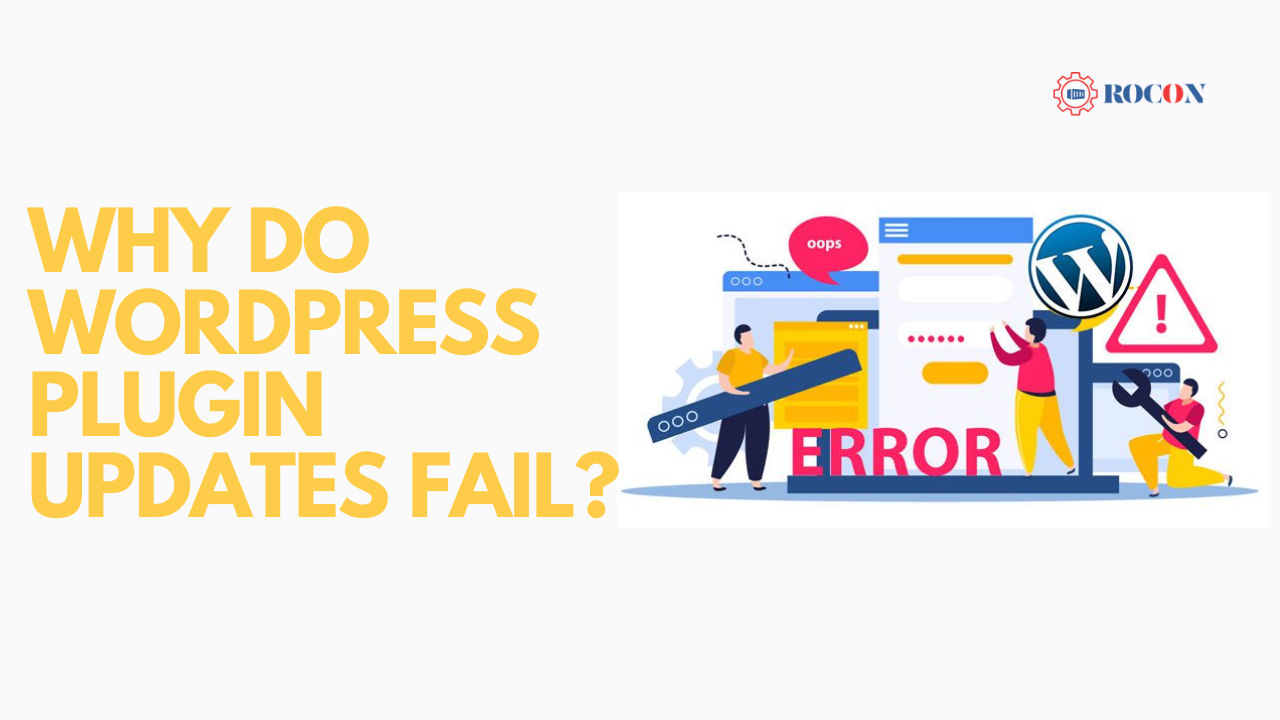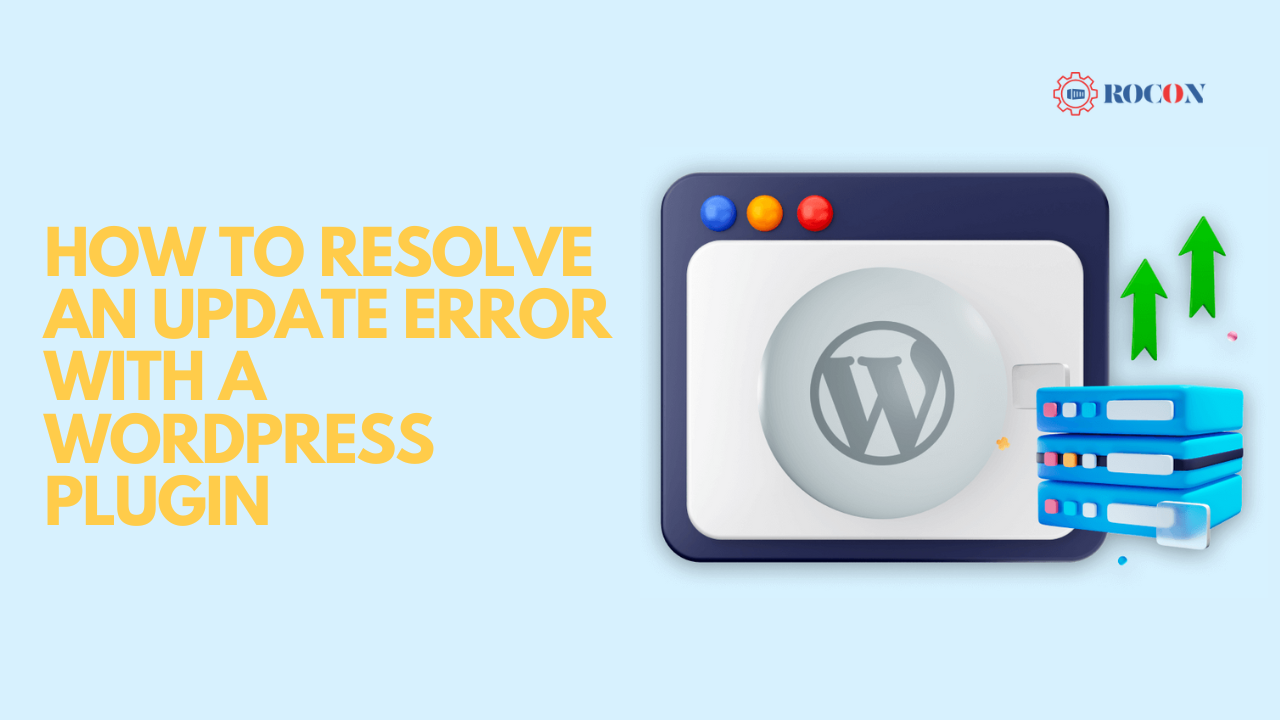Introduction: Update Failed WordPress Plugin Fix
Update Failed WordPress Plugin Fix: The flexibility, ease of use, and extensive plugin library of WordPress make it the platform of choice for millions of websites across the globe. Plugins are a part of any WordPress site, adding functionality, user experience and security. But updating plugins can be a double edged sword. Updates bring new features and security patches but can also introduce problems especially when updates fail.
A failed plugin update can break your website’s performance, security and appearance and can cause downtime or even complete failure. A WordPress website needs to know why plugin updates fail and how to resolve them.. In this guide we’ll look at the common causes of failed WordPress plugin updates and a step by step approach to fix them.

Why Do WordPress Plugin Updates Fail?
Before diving into the fixes, it’s essential to understand the root causes of failed plugin updates. Several factors can contribute to this issue, and knowing them helps prevent future problems.
1. Plugin and Theme Incompatibility
One of the most common reasons for a failed plugin update is incompatibility with your existing theme or other plugins. Since WordPress is an open-source platform, several plugins and themes are created by outside developers.
While WordPress has guidelines to ensure compatibility, conflicts can still occur.
For instance, if a plugin update introduces a new feature that requires a certain function in your theme, and that function is absent or outdated, the update may fail. Similarly, if two plugins try to use the same function or variable differently, this can lead to conflicts and errors.
2. Insufficient Server Resources
Every time you update a plugin, your server has to process the new files, replace old ones, and potentially run database updates. If your server is running low on resources—such as memory (RAM), storage space, or processing power—these tasks may not complete successfully.
Shared hosting environments, in particular, are more prone to these issues because multiple sites share the same resources. If another site on the same server is using a lot of resources, your update may time out or fail.
3. Incorrect File Permissions
WordPress operates within a file system on your server, and it requires specific permissions to read, write, and execute files. If these permissions are not set correctly, WordPress may be unable to replace existing plugin files during an update, causing the update to fail.
Permissions are typically set using numeric codes. For example, the code 755 means the owner has full permissions (read, write, and execute), while others only have read and execute permissions. Incorrect permissions can block WordPress from performing essential tasks.
4. Corrupted Plugin Files
Corruption can occur during the download or installation process of a plugin update. This may be due to a poor internet connection, an interrupted download, or issues on the plugin developer’s server. When files are incomplete or corrupted, WordPress cannot properly unpack or install them, leading to a failed update.
5. Outdated WordPress Core
Running an outdated version of WordPress can cause compatibility issues with newer plugin versions. WordPress updates often include changes to the core files that plugins rely on. If these changes are not present because your WordPress installation is outdated, the plugin may not function correctly after the update.
6. Internet Connectivity Issues
Sometimes, a failed plugin update might simply be due to poor or unstable internet connectivity. During an update, WordPress connects to the plugin repository to download the latest version. If your internet connection drops or slows down during this process, the download may be incomplete, resulting in a failed update.
7. Conflicting Caching Mechanisms
WordPress sites often use caching plugins to improve performance by serving static versions of your pages. However, these caching mechanisms can sometimes interfere with plugin updates. If a cached version of a plugin file is served during an update, WordPress might attempt to update an outdated or incorrect version of the file, leading to a failure.

How to Resolve an Update Error with a WordPress Plugin
Now that we’ve identified the potential causes of failed plugin updates, let’s explore the solutions. Fixing these issues typically involves a combination of troubleshooting, server adjustments, and sometimes manual intervention.
1. Backup Your Website
Before attempting any fix, always back up your website. This guarantees that you may return your website to its initial configuration in the event that something goes wrong throughout the troubleshooting process.. There are several WordPress plugins available, like UpdraftPlus or All-in-One WP Migration, which can automate the backup process. You should back up both your database and your files.
2. Determine the Specific Cause of the Failure
Understanding the exact reason for the update failure will guide your troubleshooting. To identify the cause, check your WordPress dashboard for any error messages or logs. You can also enable debugging in WordPress by adding the following line to your wp-config.php file:
php
define(‘WP_DEBUG’, true);
This will display detailed error messages that can help pinpoint the problem. Remember to turn off debugging after you’ve resolved the issue to prevent exposing sensitive information to visitors.
3. Resolve Compatibility Issues
If you suspect that a plugin update failed due to compatibility issues, you have several options:
- Check Compatibility: Visit the plugin’s page on the WordPress repository or the developer’s site to check for any compatibility warnings. Look for recent updates, changelogs, or user reviews that might indicate known issues.
- Disable Conflicting Plugins: Temporarily deactivate all other plugins and try updating the plugin again. If the update succeeds, reactivate the plugins one by one to identify the conflicting plugin.
- Switch to a Default Theme: Sometimes, the issue might be with your theme. Temporarily switch to a default WordPress theme (like Twenty Twenty-Three) and attempt the update again.
- Contact Plugin Support: If you identify a conflict but can’t resolve it, contact the plugin’s support team. They may be aware of the issue and can provide a fix or workaround.
4. Increase Server Resources
If you’re experiencing resource limitations, you may need to increase your server’s capacity or optimize your current resources:
- Upgrade Your Hosting Plan: If you’re on a shared hosting plan and frequently run into resource limits, consider upgrading to a VPS (Virtual Private Server) or a dedicated server. These options provide more resources and can handle higher traffic and more demanding updates.
- Optimize Your Site: Remove any unnecessary plugins and themes, optimize your database, and consider using a CDN (Content Delivery Network) to reduce server load.
- Increase PHP Memory Limit: You can increase your site’s memory limit by adding the following line to your wp-config.php file:
php
define(‘WP_MEMORY_LIMIT’, ‘256M’);
If the update still fails, you might need to increase it further, depending on your server’s capacity.
5. Correct File Permissions
To fix file permission issues, you can adjust the permissions using an FTP client like FileZilla or through your hosting control panel. Here’s how:
- Connect to Your Server: Use your FTP credentials to connect to your server.
- Navigate to Your WordPress Directory: Typically, this is the public_html or www folder.
- Check Permissions: Right-click on a file or folder and select ‘File Permissions’ to view or change the permissions.
Set the following permissions:
These settings are generally safe and should allow WordPress to update plugins without issues. Be cautious with more permissive settings like 777, as they can pose security risks.
6. Reinstall the Plugin Manually
If an update failed due to corrupted files, reinstalling the plugin is often the best solution. Here’s how to do it safely:
- Delete the Existing Plugin: Go to your WordPress dashboard, navigate to Plugins > Installed Plugins, and deactivate the problematic plugin. Then, click ‘Delete.’ This removes the plugin files but not its data from the database.
- Download the Latest Version: Visit the WordPress plugin repository or the developer’s website to download the latest version of the plugin as a .zip file.
- Install the Plugin: In your WordPress dashboard, go to Plugins > Add New, and click ‘Upload Plugin.’ Choose the .zip file you downloaded and click ‘Install Now.’ After installation, activate the plugin.
Reinstalling the plugin ensures that all files are fresh and complete, which should resolve any issues caused by corruption.
7. Update WordPress Core
Keeping WordPress itself up to date is crucial for maintaining compatibility with plugins. To update WordPress:
- Backup Your Site: As always, back up your site before making any major changes.
- Update WordPress: Go to Dashboard > Updates and click ‘Update Now.’ WordPress will automatically download and install the latest version.
After updating WordPress, attempt to update the plugin again. The issue may have been caused by outdated core files that are now resolved.
8. Troubleshoot Internet Connectivity Issues
If your internet connection is unstable or slow, this can interrupt the plugin update process. To mitigate this:
- Use a Stable Connection: Ensure you’re connected to a reliable internet source. If possible, use a wired connection instead of Wi-Fi to reduce the risk of disconnection.
- Avoid Peak Times: If you’re on a shared internet connection (e.g., in an office or at home with multiple users), try performing updates during off-peak hours when fewer people are online.
If you continue to experience issues, consider downloading the plugin update file directly and installing it manually.
9. Clear Your Cache
Caching plugins are great for improving site performance, but they can sometimes interfere with plugin updates. If you suspect this is the case:
- Clear Plugin Cache: Go to your caching plugin settings and clear the cache. Most plugins have a simple ‘Clear Cache’ button on the dashboard.
- Deactivate the Caching Plugin: If clearing the cache doesn’t help, temporarily deactivate the caching plugin and try updating the plugin again.
- Clear Server Cache: Some hosting providers also offer server-side caching. If you have access to these settings, clear the server cache as well.
After successfully updating the plugin, reactivate your caching plugin and clear the cache again to ensure everything runs smoothly.

Advanced Troubleshooting Techniques
If you’ve tried all the basic fixes and the update still fails, it’s time to dive deeper into more advanced troubleshooting. Here is the more method for Update Failed WordPress Plugin Fix:
1. Enable WP_DEBUG for More Detailed Error Logs
WordPress has a built-in debugging feature that can help you diagnose the problem more accurately. To enable it:
- Edit wp-config.php: Access your site’s files through FTP or your hosting control panel and open the wp-config.php file.
- Enable Debugging: Add or update the following lines in your wp-config.php file:
php
define(‘WP_DEBUG’, true);
define(‘WP_DEBUG_LOG’, true);
This creates a debug log file (debug.log) in the wp-content directory, where you can view detailed error messages. This can provide insights into what’s causing the plugin update to fail.
- Review the Debug Log: Check the debug.log file for any errors related to the failed plugin update. Look for patterns or recurring issues that might point to a specific cause.
- Disable Debugging After Use: Remember to set WP_DEBUG back to false after troubleshooting to avoid displaying errors to visitors.
2. Use the WordPress Recovery Mode
WordPress 5.2 introduced a recovery mode feature, which activates automatically if a plugin or theme causes a fatal error. If a plugin update fails and triggers an error, WordPress will send you an email with a special login link to access wordpress recovery mode.
- Access Recovery Mode: Use the link in the email to log into your WordPress site in recovery mode. This will allow you to deactivate the problematic plugin and perform necessary fixes without affecting the rest of your site.
- Fix the Issue: Once in recovery mode, deactivate the plugin causing the issue. You can then attempt to reinstall the plugin or apply other fixes discussed earlier.
- Exit Recovery Mode: After resolving the issue, log out of recovery mode, and log back in normally to ensure everything is functioning correctly.
3. Check Server Logs for More Information
In addition to WordPress debug logs, your server logs can also provide valuable information. These logs track server activity, including errors that might not be captured by WordPress.
- Access Server Logs: Most hosting providers offer access to server logs through the hosting control panel. Look for sections labeled ‘Logs’ or ‘Error Logs.’
- Review Logs: Search the logs for entries related to the time when the plugin update failed. Look for any errors or warnings that might indicate server-side issues, such as resource limitations or permission errors.
Server logs can be more technical, so you may need to consult with your hosting provider’s support team if you find entries that you don’t understand.
4. Consider a Fresh WordPress Installation
If all else fails, and you continue to experience issues with plugin updates, it might be time to consider a fresh WordPress installation. This is a last-resort option but can resolve issues caused by corrupted core files or deeply embedded conflicts.
- Backup Your Website: Before proceeding with a fresh installation, ensure you have a complete backup of your website, including your database, media files, and theme settings.
- Reinstall WordPress: You can perform a fresh installation by downloading the latest version of WordPress from WordPress.org and following the installation instructions. If your hosting provider offers a one-click WordPress install, you can use that option as well.
- Restore Your Site: After reinstalling WordPress, restore your site from the backup. You may need to reinstall plugins and themes manually, ensuring they are compatible with the fresh installation.
Conclusion: Update Failed WordPress Plugin Fix
Failed WordPress plugin updates can be frustrating, but with the right approach, they are entirely manageable. By understanding the common causes and following the troubleshooting steps outlined in this guide, you can quickly resolve these issues and keep your site running smoothly. Here we resolve the update failed wordpress plugin fix problem.
Remember, regular backups, testing updates in a staging environment, and maintaining all aspects of your site are key to preventing future problems. With these best practices in place, you’ll minimize downtime and ensure a seamless experience for your visitors.
Update Failed WordPress Plugin Fix FAQs
Q1: What should I do if the plugin update fails and my site breaks?
Solution: Don’t panic. Access your site via FTP and rename the plugin’s folder in the wp-content/plugins/ directory to deactivate it. This should restore your site. Then, investigate the issue or restore from a backup.
Q2: Why do plugin updates sometimes take so long?
Solution: This can happen due to slow server response times or large plugin file sizes. To fix it, consider increasing your server timeout limit or upgrading your hosting plan for better performance.
Q3: How can I avoid plugin update failures in the future?
Solution: Keep your WordPress, themes, and plugins updated regularly, maintain sufficient disk space, and ensure your PHP version is current. Also, always back up your site before making updates.
Q4: Is it safe to use automatic plugin updates?
Solution: Automatic updates are generally safe, but they can sometimes cause conflicts. It’s a good practice to review update logs and have backups in place before enabling auto-updates.

Leave a Reply